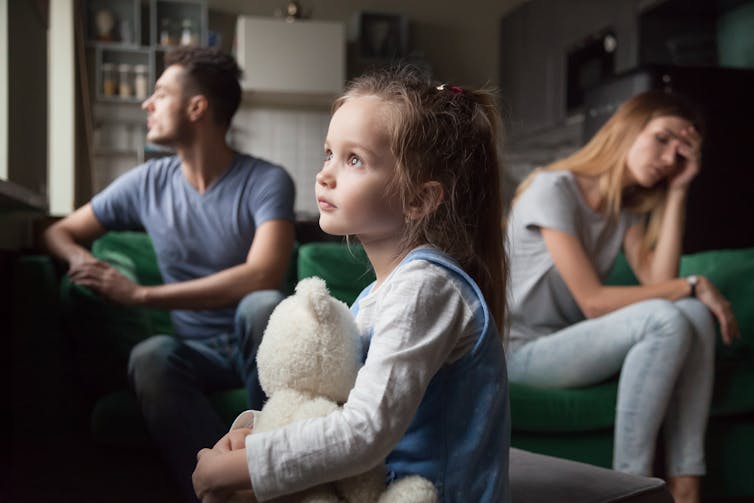Holidays are often a time of strengthening family bonds and relationships. But for those who have difficult relationships with siblings, parents and extended family, it can be a stressful and upsetting time. We asked Kristina Scharp to explain why family relationships sometimes break down – and some things to consider when talking to those in this situation.
What is family estrangement?
Family estrangement occurs when at least one family member intentionally distances themselves from at least one other family member because of a negative relationship – or the perception of one.
Research suggests that at least 27% of adults experience family estrangement that either they or another family member initiates. This means that almost 70 million people in the United States report being estranged from a family member.
What family estrangement is not
As a researcher dedicated to understanding relational distancing, one of the most common questions people ask me is, “What counts as family estrangement?”
Perhaps the confusion comes from a common misconception that estrangement is a particular event or outcome. My research shows that family estrangement is a process, one that is ongoing and varies in degree. Put simply, family estrangement is a continuum where it is more accurate to characterize people as more or less estranged, as opposed to estranged or not estranged.
Estrangement is voluntary. This means that at least one person desired the distance as opposed to a situation where a third party intervened, like the foster care system or criminal justice system.
Estrangement is intentional. The distance between family members was not an accident or an instance of people losing touch.
Estrangement is often based on ongoing issues. It is less likely that family members suddenly decide they want distance. Rather, people report a long history of conflict and negativity.
Nevertheless, there are some instances when estrangement can be more sudden. For example, sometimes parents might reject a child if they come out as LBGTQ.
Estrangement occurs because of a perceived negative relationship. People do not simply desire distance without reason. Research suggests that reasons are typically severe – abuse, neglect and substance issues, for example. Even if the family members disagree about what has happened or the state of their relationship, at least one person perceives the relationship as negative.
Taken together, estrangement is a distinct process from other instances when family members might find themselves distanced, as is the case with adoption, military deployment and migration.
One related but distinct concept is parental alienation. Although the outcome of estrangement and alienation looks similar, the reasons for distance are different.
Parental alienation occurs after divorce, when one parent intentionally harms the relationship their child has with the other parent. Nevertheless, both estrangement and alienation are major family disruptions.
fizkes/Getty Images
How do people accomplish and maintain distance?
When I began researching family estrangement, my primary question pertained not only to what estrangement was but also how people made it happen. Based on my research, adult children who distanced themselves from their parents described eight characteristics of estrangement:
• Communication quantity: The extent to which adult children communicate with their parents.
• Communication quality: The extent to which that communication is meaningful.
• Physical distance: The extent to which parents and children physically distance from one another.
• Presence/absence of emotion: The extent to which adult children feel emotion when thinking about their parent/estrangement.
• Positive/negative effect: The extent to which those emotions are positive and/or negative.
• Reconciliation/desire to be a family: The extent to which adult children hope to reconcile.
• Role reciprocity: The extent to which family members behave and care for one another in expected ways.
• Legal action: The extent to which adult children have taken any legal action against their parents, like emancipation, name change or changes to legal documents.
When considering these questions, one of the most important things to remember is that not everyone wants the same amount of communication, proximity and emotion. Thus, I like to think about estrangement as the gap between a person’s lived reality, as it pertains to the eight characteristics, and what their preferences would be if they had an ideal relationship.
Lessons learned
Although research into family estrangement is still burgeoning, here are some of the most important takeaways from my systematic research program:
• Estrangement is stressful and stigmatizing.
Many people discuss not wanting to talk about their estrangement because they fear negative reactions from others. If an estranged person decides to disclose the circumstances surrounding their estranged relationship, I encourage people wanting to provide support to refrain from immediately expressing sorrow or recommending a reconciliation. Rather, consider asking them how they feel about the distance.
• Estrangement can be a healthy solution to an unhealthy environment.
Often, estrangement can be a productive way for people to eliminate a toxic relationship. Just because people are biologically related does not guarantee a loving and supportive relationship. Sometimes, gaining distance is necessary for a person’s emotional and/or physical safety.
• Maintaining distance can be even harder than accomplishing it.
Because we live in a culture where “families are forever,” people not only have to accomplish distance but also maintain it. This maintenance is often a heavy burden, not only because people consistently recommend unwanted reconciliations but also because of both media representations of family and internalized feelings about familial obligation. Thus, even though estrangement can be a positive change for someone, it is nevertheless a difficult one.
Despite what scholars have begun to learn about family estrangement, there is an incredible amount of research still to be done. In conducting it, we might learn more about different perspectives, different catalysts for distance and the outcomes associated with it.
[Like what you’ve read? Want more? Sign up for The Conversation’s daily newsletter.]
Credit: Source link




